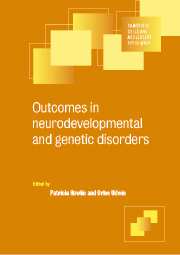Crossref Citations
This Book has been
cited by the following publications. This list is generated based on data provided by Crossref.
Tupper, David E.
2001.
Pediatric Neuropsychological Intervention.
p.
338.
Karpf, J
Turk, J
and
Howlin, P
2004.
Cognitive, language, and adaptive behavior profiles in individuals with a diagnosis of Cohen syndrome.
Clinical Genetics,
Vol. 65,
Issue. 4,
p.
327.
Wentz, Elisabet
Lacey, J. Hubert
Waller, Glenn
Råstam, Maria
Turk, Jeremy
and
Gillberg, Christopher
2005.
Childhood onset neuropsychiatric disorders in adult eating disorder patients.
European Child & Adolescent Psychiatry,
Vol. 14,
Issue. 8,
p.
431.
2006.
Van Nostrand's Scientific Encyclopedia.
Meester‐Delver, Anke
Beelen, Anita
Hennekam, Raoul
Hadders‐Algra, Mijna
and
Nollet, Frans
2006.
Predicting additional care in young children with neurodevelopmental disability: a systematic literature review.
Developmental Medicine & Child Neurology,
Vol. 48,
Issue. 2,
p.
143.
Dworzynski, Katharina
Ronald, Angelica
Hayiou‐Thomas, Marianna
Rijsdijk, Frühling
Happé, Francesca
Bolton, Patrick F.
and
Plomin, Robert
2007.
Aetiological relationship between language performance and autistic‐like traits in childhood: a twin study.
International Journal of Language & Communication Disorders,
Vol. 42,
Issue. 3,
p.
273.
Carnaby, Steve
2007.
Developing Good Practice in the Clinical Assessment of People With Profound Intellectual Disabilities and Multiple Impairment.
Journal of Policy and Practice in Intellectual Disabilities,
Vol. 4,
Issue. 2,
p.
88.
Meester‐Delver, Anke
Beelen, Anita
Hennekam, Raoul
Nollet, Frans
and
Hadders‐Algra, Mijna
2007.
The Capacity Profile: a method to classify additional care needs in children with neurodevelopmental disabilities.
Developmental Medicine & Child Neurology,
Vol. 49,
Issue. 5,
p.
355.
Farley, Megan A.
McMahon, William M.
Fombonne, Eric
Jenson, William R.
Miller, Judith
Gardner, Michael
Block, Heidi
Pingree, Carmen B.
Ritvo, Edward R.
Ritvo, Riva Arielle
and
Coon, Hilary
2009.
Twenty‐year outcome for individuals with autism and average or near‐average cognitive abilities.
Autism Research,
Vol. 2,
Issue. 2,
p.
109.
Helverschou, Sissel Berge
Bakken, Trine Lise
and
Martinsen, Harald
2011.
International Handbook of Autism and Pervasive Developmental Disorders.
p.
53.
Phelps, Brady I.
2011.
Encyclopedia of Child Behavior and Development.
p.
1137.
Turk, Jeremy
O'Brien, Gregory
and
Bevan, Ruth
2011.
Recent advances in behavioural phenotypes as they affect adults.
Advances in Mental Health and Intellectual Disabilities,
Vol. 5,
Issue. 4,
p.
5.
Osório, Ana
Garayzábal-Heinze, Elena
Villaverde, María Lens
and
Sampaio, Adriana
2013.
Neurodevelopmental features of Smith–Magenis syndrome: strengths and weaknesses.
International Journal of Developmental Disabilities,
Vol. 59,
Issue. 3,
p.
156.
Bakken, Trine L.
and
Høidal, Siv H.
2014.
Asperger syndrome or schizophrenia, or both? Case identification of 12 adults in a specialized psychiatric inpatient unit.
International Journal of Developmental Disabilities,
Vol. 60,
Issue. 4,
p.
215.
Perret, Patrick
2014.
Psychologie et handicap.
p.
31.
Estabillo, Jasper A.
Matson, Johnny L.
and
Jiang, Xinrui
2016.
The association between familial ASD diagnosis, autism symptomatology and developmental functioning in young children.
European Child & Adolescent Psychiatry,
Vol. 25,
Issue. 10,
p.
1133.
Burack, Jacob A.
Russo, Natalie
Green, Cathryn Gordon
Landry, Oriane
and
Iarocci, Grace
2016.
Developmental Psychopathology.
p.
1.
Yatawara, C J
Einfeld, S L
Hickie, I B
Davenport, T A
and
Guastella, A J
2016.
The effect of oxytocin nasal spray on social interaction deficits observed in young children with autism: a randomized clinical crossover trial.
Molecular Psychiatry,
Vol. 21,
Issue. 9,
p.
1225.
Mithieux, Bernard
2016.
L’accompagnement thérapeutique d’une enfant Smith-Magenis. Paradigme d’une thérapie des enfants porteurs d’une anomalie génétique ?.
Enfances & Psy,
Vol. N° 69,
Issue. 1,
p.
143.
DeMayo, Marilena M.
Song, Yun Ju C.
Hickie, Ian B.
and
Guastella, Adam J.
2017.
A Review of the Safety, Efficacy and Mechanisms of Delivery of Nasal Oxytocin in Children: Therapeutic Potential for Autism and Prader-Willi Syndrome, and Recommendations for Future Research.
Pediatric Drugs,
Vol. 19,
Issue. 5,
p.
391.



